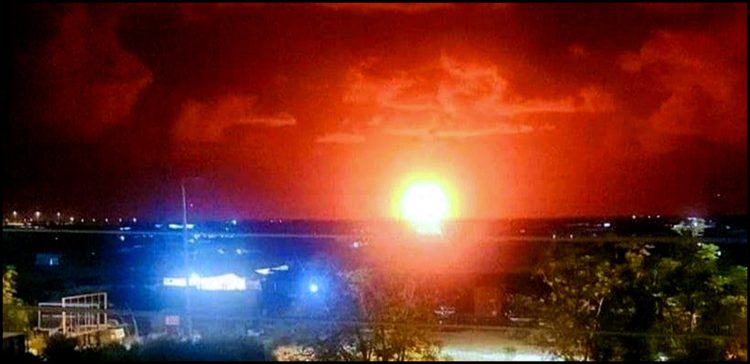The Attack
On the night of October 1, Iran launched an attack of some 200 to 400 intermediate-range ballistic missiles (IRBMs) on Israel. This was retaliation for two Israeli attacks: 1) Israel’s assassination of Hamas’s political chairman, Ismail Haniyeh in Tehran on the day of the new Iranian president’s inauguration, and 2) the attack by Israel on South Beirut that killed Hezbollah’s Hassan Nasrallah and Iran’s Brigadier General Abbas Nilforushan. The Beirut attack collapsed at least four apartment buildings and killed up to 1,000 civilians living above the underground bunker (see this article: Mechanics of Bunker Busting: Killing Nasrallah).
The Iranian attack struck military targets. There was only one report of a civilian fatality. The Iranian IRBM attack was conducted in conjunction with a Hezbollah artillery rocket attack, and the latter may have caused the civilian casualty.
Iranian IRBM targets were three Israeli Air Force (IAF) airfields:
Ort Tel Nof Airbase,
Nevatim Airbase (base for IAF F-35s), and
Hatzerim Airbase (base for IAF F-15s used to kill Nasrallah and Nilforushan)
The IRBMs also struck Mossad HQ in Glilot, Tel Aviv (reportedly a near miss with a huge crater outside), David’s Sling air defense missile launch sites, and various air defense radar sites. The radar sites were probably mapped using electronic warfare data collected during the April 13 attack. That Iranian attack was conducted in retaliation for Israel’s air strike on the Iranian embassy in Damascus.
The Weapons
On April 13, Iran launched a large, choreographed attack on Israel using drones and some obsolete IRBMs. This was done in retaliation for the Israeli air strike on the Iranian embassy in Damascus, Syria. That air strike killed a number of IRGC officers on embassy grounds – sovereign Iranian territory. The US made diplomatic overtures to Iran asking Iran not to retaliate, or at least, minimize the retaliation to prevent regional escalation.
Iran conceded and did two things. 1) Iran gave the US and Israel 48 hours’ notice of the April 13 attack so Israel and coalition countries could prepare, and 2) Iran opened the attack with 300 drones that took five hours to reach Israel, giving the defense even more time to get ready. All the drones were shot down, but it is doubtful that air defense hit the handful of obsolete IRBMs. Some of the IRBMs broke up on re-entry. However, several hit their targets.
The drones, which carry 100-pound warheads, would inflict material damage. They had to be shot down with expensive air defense missiles. Israel and the coalition lit up their whole radar network, allowing the Iranians and Russians to map their frequencies and locations (see Electronic Warfare: Iran’s Drone Strategy Against Israel for details). The Iranian message was “We can hit you. These were our second-tier weapons. Next time we’ll hit you with our good stuff.”
The Israelis and western officials flooded the media with news of a great coalition victory. They announced that 99% of Iranian attack vehicles were shot down, and they denigrated Iranian weapons as junk.
Why is this important?
It’s important because this time, on October 1, the Iranians had the Israeli air defense network pre-mapped, and this time they used their good stuff. They used modern IRBMs. No drones. No warning. Flight time from Iran to Israel was 10 minutes. Speed Mach 10.
Estimates of the number of missiles fired vary from 200 to 400. I’m going to go with 300, but it doesn’t really matter. The probability of an anti-ballistic missile (ABM) hitting an incoming target is less that 1.0, so defenders have to fire two or even three ABMs for each threat. That means Israel and the coalition had to fire 600 to 900 air defense interceptors, each costing between $500,000 and $2,000,000 depending on the platform. Costs rise quickly, and it is worth noting that Israel had probably not fully restocked its armories in the five months since the April 13 attack.
Note that Iran did not use their modern, highly accurate cruise missiles. Note also that 400 IRBMs is a fraction of their arsenal. Figure 2 shows one of many salvos the Iranians unleashed that night.
Figure 2. Salvo of Iranian IRBMs heading west at Mach 10. Flight time to Israel 10 minutes
The Iranian attack was launched in conjunction with Hezbollah. Hezbollah attacked with less sophisticated and less accurate artillery rockets. This was a saturation attack. Iran and Hezbollah fired so many rockets and missiles they overwhelmed the Israeli and coalition air defense. Israel conceded that they did not have enough ABMs to engage all threats.
In summary, there were two types of attacking vehicles: Modern Iranian IRBMs and Hezbollah artillery rockets.
What is Hypersonic?
Let’s digress briefly. Readers will see the word “Hypersonic” used liberally. It’s a red herring. “Hypersonic” refers to speeds above 5 times the speed of sound, or Mach 5. Almost all IRBMs are hypersonic in their terminal phase, as were these Iranian missiles. Even the German V-2 of World War II was hypersonic at impact and gave no warning.
I use the term “hypersonic” to describe missiles that have the ability to maneuver and travel at Mach 5 or higher. That means hypersonic cruise missiles and hypersonic glide vehicles. I will not refer to any of the missiles used on October 1 as “hypersonic” because they were ballistic missiles, not maneuvering missiles.
The Defense
Israel and the coalition (principally the United States, though Jordan also raised its hand) has a wide range of air defense missiles. Indigenous Israeli missiles are: 1) Iron Dome, 2) David’s Sling, and 3) Arrow 1 and 2. The reader will hear “Iron Dome” used endlessly in the media, more often than not incorrectly. It’s all they hear, so media personalities use “Iron Dome” the way people refer to photocopies as “Xeroxes” regardless of the copier that produced them.
Oh well. We need to be a little bit more precise.
The Israeli air defense is layered. Iron Dome is meant to stop artillery rockets (like those of Hezbollah) and drones. I refer the reader to Houthi Attack on Tel Aviv: Questions About Aegis ABM Defense that includes reference videos that discuss Israel’s air defense.
Iron Dome is a low-altitude interceptor intended to counter artillery rockets, against which it is only marginally effective. Its empirical hit probability is on the order of 4% or 5%. It is absolutely useless against IRBMs. IRBMs are moving far too fast for Iron Dome to have any hope of intercepting. Iron Dome would have been completely useless against Iran’s attack. Its best use is against slow-moving drones, that close at a speed of about 130 to 150mph.
David’s Sling and Arrow are intended to intercept attacking ballistic missiles at medium and high altitude. Their effectiveness is also questionable.
The Israelis had a few US-supplied Patriot and THAAD missiles batteries. The article Houthi Attack on Tel Aviv: Questions About Aegis ABM Defense and videos referenced therein describe Ted Postol’s evaluation of the Patriot PAC-3 system.
Patriot PAC-3 is extremely effective against aircraft, drones, and subsonic cruise missiles. Unfortunately, there were none of those used on the night of October 1. Its track record against ballistic missiles is suspect.
The US Navy had two Aegis destroyers in the Eastern Mediterranean equipped with AN/SPY-1 radar and Standard 3 ABMs. The destroyers were specifically equipped for ABM defense, yet their participation is a mere footnote. The Pentagon reported that the destroyers fired twelve missiles against some 300 Iranian IRBMs. Last week, the Houthis fired an IRBM from Yemen that travelled 2,000km up the Red Sea and hit Tel Aviv. It overflew two US Navy Aegis destroyers and was not challenged. See this article for details of the mystery: Houthi Attack on Tel Aviv: Questions About Aegis ABM Defense. The MIT paper by Lewis and Postol, Lewis & Postol: Technical Analysis of Flaws in Standard 3 is a highly recommended treatise on the Aegis Standard 3 ABM.
Suffice to say that twelve Standard 3s against 300 incoming IRBMs isn’t a fair fight even if we grant the Standard 3 a generous hit probability of 33-50%. With two missiles per engagement, they would have swung at six IRBMs. With three per engagement, they would have swung at four. Those babies did not pull a lot of freight that night.
US officials described the October 1 attack as “defeated and totally ineffective” and “a complete failure.” That was within an hour of the attack and before any battle damage assessment. They made those statements live while people were still watching videos that showed salvos of Iranian IRBMs raining on Israeli targets. On split-screens, no less.
To its credit, the Pentagon said they were still evaluating BDA. The Pentagon spokesman had some grasp and did a credible job.
Video 1 shows an incoming salvo of Iranian IRBMs:
Video 1. Iranian IRBMs Strike Israel Unopposed
I want to take the reader through some videos so he can look at other videos published by the media and examine them critically. Video 1 shows half a dozen IRBMs, in terminal phase, striking their targets. They travel down from the upper right of the screen to the center and lower left. If air defense missiles were fired, their rocket motors would leave trails extending upward from the bottom of the screen. There are none. These Iranian IRBMs struck their targets unopposed.
It is worthwhile noting that some videos were geolocated using OSINT (Open Source Intelligence). The geolocation confirmed that the Iranian missiles hit at least three of their targets – Nevatim AB, Ort Tel Nof AB, and a near-miss outside Mossad HQ). These are the geolocations I am aware of. They almost certainly hit the other targets also.
What does a successful interception look like? Study Video 2.
Video 2. Incoming IRBM Salvo with One Possible Interception
In this video, we clearly see a large salvo of Iranian IRBMs falling on their targets. About seven seconds into the video, we see a small, but not very bright, explosion in the upper right section of the screen. I think this might have been an interception, most likely a partial interception. What do I mean by that?
To be effective, the ABM interceptor has to hit the incoming warhead. It is not enough to hit the incoming IRBM halfway along its cylindrical body from the side. Why? If the ABM hits the IRBM from the side, the ABM will blow the IRBM in two, or knock it off course. The IRBM warhead will fall off, and continue on some trajectory. It might miss, but it might not. It might hit something else. Now, the IRBM warhead contains 500 to 1,000 pounds of explosive. So if the ABM hits the IRBM warhead, both the ABM and IRBM will explode, producing a huge flash. The flash in Video 2 was small – suggesting that an ABM hit an incoming IRBM from the side, and the IRBM warhead broke off.
Let’s look at a successful interception. Study Video 3. Incoming IRBMs with Good Interception 18-21 seconds into video
This is a helpful video. We see the salvo of missiles falling on their targets. The vast majority get through. We also see an interceptor rocket traveling upwards from the bottom left to the upper right. If we look closely, we see a curved white trail. That is the trail of another interceptor that tried to course-correct to hit an IRBM.
Twenty seconds into the video, we see a very bright flash. That is the flash of an ABM interceptor hitting an IRBM on its warhead. That was a successful interception.
Figure 3. From Video 3, a successful IRBM interception. On the right, we see the faint trail of a maneuvering ABM. Below, IRBM strikes on target.
Figure 3. From Video 3, a successful IRBM interception. On the right, we see
the faint trail of a maneuvering ABM. Below, IRBM strikes on target.
The thing to take away from these videos is that the vast majority of incoming missiles got through, many of them unopposed. I have studied a large number of videos shot the night of October 1. In my opinion, the average empirical hit rate of interceptors was no better than 10%. I am being generous. It was probably more like 5%, but I’ll give them 10%. For simplicity, I considered partial interceptions to be interceptions.
I encourage readers to study Houthi Attack on Tel Aviv: Questions About Aegis ABM Defense and watch the linked Ted Postol videos. Then watch as many other videos of the attack as possible and draw conclusions. Then, the next time a talking head looks at the camera and says, “The attack was defeated and completely ineffective,” the reader can make his own assessment of what happened.
Conclusions
Analysis of a large number of videos suggests that on October 1, about 90% of Iranian and Hezbollah IRBMs and artillery rockets hit their targets. Targets were three IAF air bases, David’s Sling launch sites, air defense radars, and Mossad HQ. No civilian sites were hit. Unfortunately, Battle Damage Assessment is not available open source. IDF will certainly say no damage was sustained. The Russians will share satellite imagery with the Iranians.
Iran and Hezbollah followed a saturation strategy. They fired so many missiles that they overwhelmed Israeli and coalition air defense. They leveraged intelligence gathered during Iran’s April 13 choreographed attack.
Israel is aware of the limitations of its air defense and was conserving its missiles. For example, it knows Iron Dome is ineffective against IRBMs and probably reserved it for use against artillery rockets.
Aegis air defense was no factor. Twelve Standard 3 ABMs launched from two destroyers were insignificant against 300 incoming IRBMs.
Given the condition of their air defense, Israel and the coalition need to consider their next moves with great care. This attack was far more damaging than the kabuki theatre of April 13, but it remains a relatively limited attack. Iran has a lot more where those IRBMs came from.
About the Author
Cameron Curtis may be reached at [email protected]
He is the author of the Breed action thriller series, available on Amazon. The stories are adrenaline-fuelled and emotionally engaging. The novels combine credible premises based on current events, technical detail, and propulsive plotting.
Check out his new Breed thriller, BLOWBACK, here: BLOWBACK by Cameron Curtis available for download now at just $0.99



